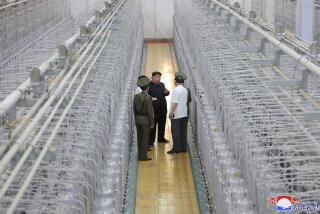Changing Times and Mission Surface at Nuclear Test Site : Nevada: Energy Department officials are pursuing alternative uses for the facility. A high security building and its reinforced weapons assembly bays provide special opportunities.
- Share via
YUCCA FLAT, Nev. — During the Gulf War, one of the most perplexing problems facing U.S. military strategists was how to penetrate hardened Iraqi facilities buried deep underground.
They found their answer at the Tonopah Test Range, a facility north of the Nevada Test Site, where high-tech weapons are paired with delivery vehicles ranging from supersonic jets to missiles.
A powerful bomb that burrows into the ground, then explodes when it reaches the buried target, was hurriedly tested at Tonopah, then rushed to the Gulf and used successfully.
Terry Vaeth, acting manager of the Energy Department’s Nevada Operations Office, believes the sprawling Nevada Test Site can help solve similar military puzzles, now that the days of nuclear testing may be over.
A test moratorium begun in 1992 remains in effect.
The labyrinth of tunnels carved in hardened mesas at the northern end of the test site have been used for years to conduct nuclear weapons tests for the Pentagon’s Defense Nuclear Agency. The tests, known as weapons effects tests, involved nuclear blasts in a simulated space environment to determine how U.S. military and space hardware could survive a nuclear blast.
Some Star Wars research is also believed to have been conducted in the remote tunnels, although the military and the DOE refuse to acknowledge such tests.
With 50 miles of hardened tunnels at the Nevada Test Site, the site could be an excellent lab to “put together a program as to how tunnels or underground bunkers could be destroyed,” Vaeth said during a recent tour of the site.
The Defense Department also needs to know how to neutralize or destroy chemical or nuclear weapons that might be developed by rogue nations such as Iraq, North Korea and Libya.
Vaeth believes the remote desert site can help in that research.
Energy Department officials are pursuing alternative uses for the 1,350-square-mile site, knowing their options are limited by 44 years of nuclear testing.
“In the past, underground testing chased away all other customers,” Vaeth said. Those days may be over, with a test moratorium remaining in effect and growing indications that future nuclear weapons testing will be done via computer simulation, not detonation.
Vaeth cites the new $100-million Device Assembly Facility, one of only two facilities in the country where nuclear devices can be assembled or disassembled. The other is the Amarillo, Tex., Pantex plant.
The Device Assembly Facility was built to allow Lawrence Livermore and Los Alamos--the two labs that design nuclear weapons--to assemble them close to the point where they would be tested. Begun in 1987, it is scheduled for completion this spring.
Vaeth said there are “alternatives on the drawing board” for the high security building and its reinforced weapons assembly bays.
“The department (DOE) looks at it as the most modern nuclear-capable facility we’ve got,” Vaeth said.
“We see DAF (Device Assembly Facility) as a facility for stockpile inspection, checking for aging problems in (nuclear) weapons, cracks, etc. We could do a complete 50,000-mile checkup.”
A few miles from the Device Assembly Facility is the Liquefied Gaseous Spill Facility, where oil and chemical companies “can learn how to clean up what they produce,” Vaeth said.
The $7.9-million complex is the only place in the United States where federal agencies and private companies can test the characteristics of hazardous liquids and gases, and how to clean them up in an environmental accident.
Nevada Test Site is also a leading contender for new solar energy programs, and has been designated an Environmental Research Park, where scientists and students can conduct research on environmental issues.
The DOE is searching out new customers who need a remote site to do testing.
“Lots of agencies need that service,” Vaeth said. “We’ve always said no because of our testing mission. Now we have an opportunity to say yes.”
Cognizant of public and political opposition to a high-level nuclear waste dump at nearby Yucca Mountain, Vaeth said he hopes people will make “an educational choice, not an emotional choice” on future uses of the site.
He doesn’t want to see Nevada Test Site become a Cold War relic.
“Testing doesn’t go on, so we’re not a sexy place anymore,” he said.
“People don’t realize we can do more for our country.”
More to Read
Sign up for Essential California
The most important California stories and recommendations in your inbox every morning.
You may occasionally receive promotional content from the Los Angeles Times.













